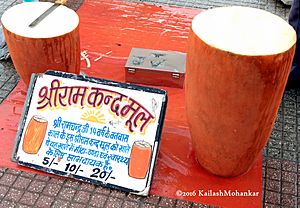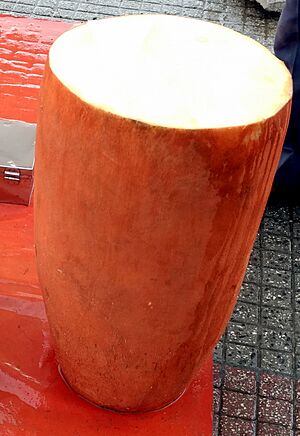Ram Kand Mool facts for kids
Ram Kand Mool is a special plant part, like a big root or tuber, shaped like a drum. You can mostly find it in parts of India, like Karnataka, Andhra Pradesh, Telangana, and Maharashtra. It's not as well-known as some other roots. People also call it kand mool, Ramkand, or Rama Chandra Kandmool in northern India. In Tamil Nadu, it's known as Boomi sakkarai Valli Kizhangu.
Contents
Discovering Ram Kand Mool
Ancient Stories and Ram Kand Mool
According to old stories, a long time ago, Lord Rama, his wife Sita, and his brother Lakshmana ate Ram Kand Mool. They ate it when they were living in the forest during their exile.
Scientists Study Ram Kand Mool
In the 1980s, plant scientists in India tried to learn more about Ramkand. They wanted to find out exactly what kind of plant it was. But they didn't have much luck at first.
What Did Scientists Find?
Later, in 1994, scientists at Shivaji University in Kolhapur used a special method called DNA testing. This helped them identify the Ramkand plant. They found out it is a type of Agave Americana. Agave plants are known for their thick, fleshy leaves.
However, this discovery also caused some confusion. The plant's inner structure looked like a "monocot" plant. Monocots usually have roots that spread out, not a single main root like a taproot. This made scientists wonder more about its true origin.
How They Identified the Plant
To solve the mystery, scientists got some Ram Kand Mool slices from a seller. The slices were about 4.5 inches wide and very thin. They took these slices to the lab.
There, they carefully took out the plant's DNA. They looked at a specific part of the DNA to identify the plant species. Their research showed that the DNA was 89 percent similar to a plant called Agave sisalana. This helped them confirm its connection to the Agave family.
Eating Ram Kand Mool

You can often find Ram Kand Mool during the summer months. It's usually sold as a street snack. Vendors cut it into very thin slices. They wrap these slices in leaves or paper for you to eat.
People often add different toppings to it. These can include honey, palm sugar, lime juice, salt, and chili powder. Sellers often say that eating Ram Kand Mool can help cool your stomach. They also claim it can help satisfy your thirst on a hot day. It is usually eaten raw, meaning it's not cooked.
Ram Kand Mool is full of starch, which is a type of energy. It is also believed to have some health benefits. Some people even use Ramkand in a powdered form as part of traditional medicines.


